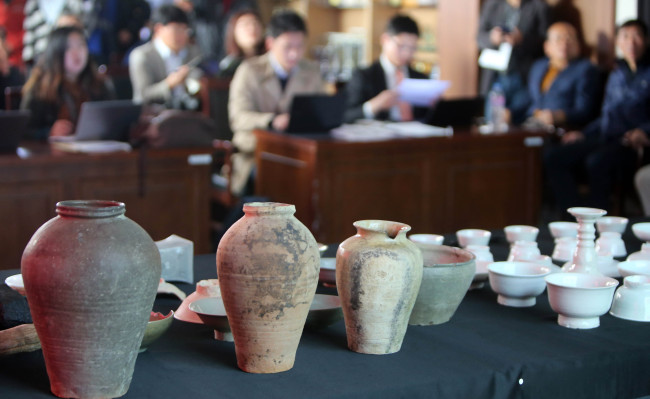A shipwreck with more than 100 pieces of earthenware, presumed to date back to 18th- or 19th-century Korea, has been found in western waters in what archeologists say could be the first discovery of a Joseon-era ship.
The National Research Institute of Maritime Cultural Heritage said Wednesday that its underwater research team discovered what appeared to be a vessel’s stern and some wooden beams on the seabed off Mado Island, Taean County, South Chungcheong Province.
“A pilot excavation of the shipwreck site resulted in the discoveries of two buncheong-ware ceramics. It’s highly likely that the vessel is from the Joseon era,” the institute said in a press release.
 |
Ceramics recovered from a shipwreck off Mado Island are on display during a press conference in Taean, South Chungcheong Province, Wednesday. (Yonhap) |
Buncheong refers to ceramics with a gray or bluish-green body, decorated with white. It is associated with the earlier part of the Joseon Dynasty (1392-1910).
The salvaging of 111 pieces of white ceramics ― all thought to date back to the late 18th or early 19th century ― from the sea floor near the shipwreck site also increased the likelihood of the vessel being a Joseon-era relic.
“It seems that the ceramics were the cargo of this vessel, as they are found bundled and stacked up,” it said.
A full-scale excavation is slated for April 2015.
The ship, which is thought to measure 11.5 meters long and 6 meters wide, may have sunk while crossing turbulent waters off Mado Island.
Since 2007, four ancient shipwrecks ― all believed to date back to the Goryeo Kingdom, which preceded Joseon ― have been found in the area, leading to the discovery of nearly 30,000 relics, some of which were valued as National Treasures.
Maritime archeologists describe the area as an underwater treasure trove.
In Korea’s relatively short history of maritime archeology and excavation, 12 ancient shipwrecks have been identified. Among them, 11 are thought to be from the Goryeo Kingdom.
By Lee Sun-young (
milaya@heraldcorp.com)








![[Weekender] Korea's traditional sauce culture gains global recognition](http://res.heraldm.com/phpwas/restmb_idxmake.php?idx=644&simg=/content/image/2024/11/21/20241121050153_0.jpg)